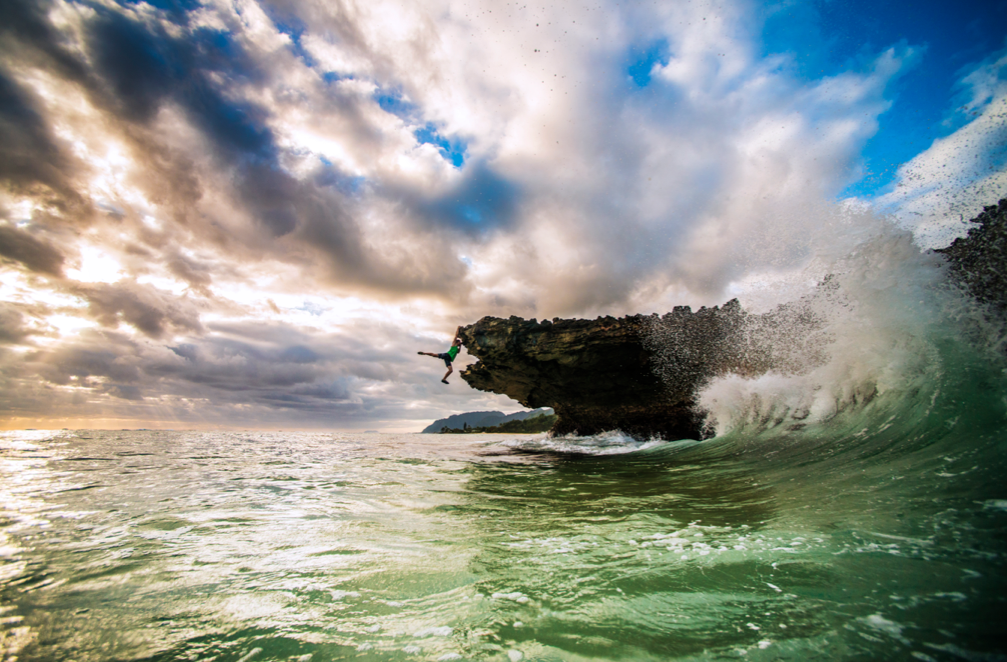“But man is not made for defeat, he said. A man can be destroyed but not defeated.” –Ernest Hemmingway, The Old Man and the Sea
CLIMBING AT THE SHORE
Text by Lisa Yamada
Image by Ryan Moss
Climbing Pounders Beach in Laie on Oahu’s North Shore without the aid of ropes or harnesses makes Justin Ridgely’s ascent perilous. Despite this, the avid boulderer moves swiftly from hold to hold, following the natural lines of the rock formation with broad, spider-like movements. Ridgely is the owner of Volcanic Rock Gym in Kaka‘ako, the only indoor bouldering gym of its kind in Hawai‘i.
It’s where climbers both novice and advanced can get a workout on the colorful walls Ridgely built from the ground up while honing their skills to prepare for the expert-level natural boulders found outdoors.
And while it looks challenging, the brawny, six-foot-something Ridgely acknowledges: “There’s stuff that is going to be easier for you than it is for me. It’s about allowing your mind to embrace that thought and to try everything and being able to feel what you’re doing wrong. It’s more than just try harder or be stronger.”
Unlike top-rope or lead climbing, bouldering utilizes body positioning and movement rather than sheer strength or equipment.
“Just like yoga, if you’re in a perfect stance or position, the move will feel effortless,” says Ridgely. “With bouldering, whether it’s overhung or you’re standing on your feet, no matter what, body positioning helps out.”
Ridgely has documented 44 climbing sites that he and friends have found, cleaned, and climbed. For more information on these sites or Volcanic Rock Gym, located at 432 Keawe St., visit hibouldering.com.

SURFING DOWNWIND
Text by Anna Harmon
Image by Morgan Hoesterey
Hawai‘i has always been a land of watermen and women, perhaps most well known for being the birthplace of surfing, where ali‘i, ancient Hawaiian chiefs, danced atop the foamy seas. Despite surfing’s celebrated history, it
was downwind surfing that brought the ali‘i here in the first place, paddling hundreds of miles on outrigger canoes from Polynesia. Downwind surfing requires tradewinds and open-ocean swells and can be done with multiple-person or solo canoes, kayaks, or stand-up paddleboards. To leave the beach behind and risk losing your vessel to rogue waves or squalls takes guts. It’s a sport that demands real respect, even if it doesn’t draw huge crowds and sponsors. For the folks who do it, this is perfect. It leaves them space to roam.
“Just picture you’re looking at Diamond Head right now, then you look out past the surf and see the wind blowing all those little white caps all over the place,” says North Shore lifeguard and downwind surf fanatic Kirk Ziegler. “If you were to paddle against it, the wind would be blowing in your ear and in your face. … Then you turn around and it’s quiet, because the wind’s on your back. You don’t see the white caps anymore; you just see a wave to your left, a wave to your right, a wave in front of you, and you just paddle in.”
Hawai‘i’s downwind surfers, as well as those around the country, can travel the islands to compete in various races that take place every year, such as the Kaiwi Channel, a 26-mile water path that stretches from Moloka‘i to O‘ahu.
But while races offer recognition of skills honed and training paid off, the majority of downwind surfers in Hawai‘i don’t do it for glory; they do it to get intimate with the signature tradewinds, challenging waves, ocean tradition, and scenic views of the place they call home.

KAYAKING ALONG THE COAST
Text by Matt Luttrell
Image by Ted John Jacobs
A tiny swell pushes our kayak closer to the cliffs rising vertically from the sea, but we hardly notice. Just an hour into our four-day kayak trip and we are already awestruck by the imposing landscape. Letting out a loud hoot, our voices bounce around the walls of the huge aquatic amphitheater.
Since commercial airplanes began flying to Hawai‘i in the 1930s, and Hollywood made the islands an international destination in the 1950s, there are fewer unspoiled, raw tracts of tropical paradise left for escape. Kayaking, however, allows one to explore undisclosed locales not accessible by foot.
Perhaps the most scenic kayaking tour is the Na Pali Coast, famous for its untouched, serene tropical terrain, dramatic cliffs, deep ocean caves, and lush valleys. The main two options for independently exploring Na Pali are to either hike 11 miles (each way) of Kalalau Valley or kayak 18 miles down the coast, ideally floating with the wind, starting from Ke‘e Beach and ending in Polihale State Park.
On the first leg of our journey, we explore Waiahuakua, which at 1,155 feet is one of the longest sea caves in the world.
After landing at Kalalau Beach, the perfect place for a base camp, we make our way to Honopu, swimming lackadaisically at the secluded beach, peering in wonder at the small schools of fish underwater, and marveling at the towering cliffs that surround us.
Leg two of our kayak adventure continues on to Miloli‘i, into an open-ocean cave where translucent water glows at the entrance to the lava tube, reflecting off the shallow bottom. We paddle back toward our pick-up spot on Polihale Beach. The beach is packed when our yellow kayaks glide over the turquoise water, bumping up onto the shoreline.
It was grueling paddling around the 18-mile coastal trek, physically and mentally exhausting, but sights made the journey worth it.

